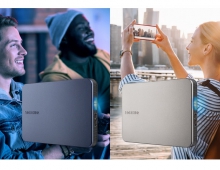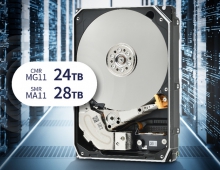
Toshiba develops 36GB advanced optical disc
Toshiba Corp. has developed a dual-layer rewritable optical disc for use with the blue-laser-based Advanced Optical Disc (AOD) format that it's developing with NEC Corp.
The disc, which will be introduced at the Optical Storage 2003 conference in Vancouver, British Columbia, next week, is the same size as a CD or DVD and is capable of storing up to 36GB of data. It's one of two rewritable disc types that make up the initial AOD format proposal, the other being a single-sided disc capable of storing 20GB. The AOD format also includes 15GB and 30GB read-only disc types.
In comparison, between 4.7GB and 9.2GB can now be stored on a DVD disc.
The AOD format was proposed by Toshiba and NEC Corp. to the DVD Forum earlier this year as a next-generation replacement for the DVD format. It will compete in the market with Blu-ray, which is also based on blue-laser technology and is being developed by a consortium of nine consumer electronics companies: Sony Corp., Hitachi Ltd., LG Electronics Inc., Matsushita Electric Industrial Co. (Panasonic), Philips Electronics NV, Pioneer Electronics Corp., Samsung Electronics Co., Sharp Corp. and Thomson Multimedia SA.
Both AOD and Blu-ray are able to store more data than DVDs because of the use of blue lasers. Blue light has a shorter wavelength than the red light used in CD and DVD systems, and so the laser beam makes a smaller spot on the disc surface. That means each bit of data takes up less space on the disc, allowing more data to be stored on a 12-cm disc.
The Blu-ray format is already on the market. Sony put a Blu-ray video recorder on sale in Japan last month to gauge market reaction. The BDZ-S77 carries a premium price of $3,820 to match its cutting-edge technology.
AOD is a little further from commercialization.
Format finalization within the DVD Forum is scheduled to be completed later this year, and development of the initial version of AOD is expected to be finished sometime in 2004, said Junko Furuta, a spokeswoman for Toshiba in Tokyo. Since a commercial launch will also depend on market readiness, the company has yet to decide on when AOD products might go on sale, she said.
Both NEC and Toshiba recently demonstrated AOD drives suitable for use in PCs at the CeBIT electronics show in Germany. Toshiba was displaying a mock-up, but NEC has a functioning drive and demonstrated high-definition video playback through a computer.
In comparison, between 4.7GB and 9.2GB can now be stored on a DVD disc.
The AOD format was proposed by Toshiba and NEC Corp. to the DVD Forum earlier this year as a next-generation replacement for the DVD format. It will compete in the market with Blu-ray, which is also based on blue-laser technology and is being developed by a consortium of nine consumer electronics companies: Sony Corp., Hitachi Ltd., LG Electronics Inc., Matsushita Electric Industrial Co. (Panasonic), Philips Electronics NV, Pioneer Electronics Corp., Samsung Electronics Co., Sharp Corp. and Thomson Multimedia SA.
Both AOD and Blu-ray are able to store more data than DVDs because of the use of blue lasers. Blue light has a shorter wavelength than the red light used in CD and DVD systems, and so the laser beam makes a smaller spot on the disc surface. That means each bit of data takes up less space on the disc, allowing more data to be stored on a 12-cm disc.
The Blu-ray format is already on the market. Sony put a Blu-ray video recorder on sale in Japan last month to gauge market reaction. The BDZ-S77 carries a premium price of $3,820 to match its cutting-edge technology.
AOD is a little further from commercialization.
Format finalization within the DVD Forum is scheduled to be completed later this year, and development of the initial version of AOD is expected to be finished sometime in 2004, said Junko Furuta, a spokeswoman for Toshiba in Tokyo. Since a commercial launch will also depend on market readiness, the company has yet to decide on when AOD products might go on sale, she said.
Both NEC and Toshiba recently demonstrated AOD drives suitable for use in PCs at the CeBIT electronics show in Germany. Toshiba was displaying a mock-up, but NEC has a functioning drive and demonstrated high-definition video playback through a computer.





















